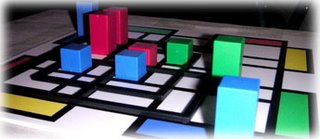
It's been a long day of gaming! I think this was our longest game day yet... Only Jay and I (Chris) remained. We were just sitting there talking when Don from Campus Life came over and asked to play a game. You don't have to tell us twice -- that's why we're here!
I had bought a game called Ido that morning on the way into work. I had gone over the directions, and messed with the pieces, but hadn't played it yet. I was obviously itching to play my new game!
Ido is an interesting game -- in its roots, it is as simple as Parcheesi or Sorry!, you have pieces in your color. You need to move your pieces from a start place to an end place before your opponent can. But that is where any similarities end.
The main board is an irregular grid -- it's not like a chessboard, some squares are smaller than others. And it has a second part -- there is a grid that sits on the board; it looks a little like a square stove burner.
During your turn, you have 3 options: introduce a new piece onto the board, move your piece(s) on the board, or shift the grid, changing the pattern of squares on the board.
You have 2 kinds of playing pieces -- a short cube (think of it as a 1 x 1 x 1 sized cube), and a taller piece (think of that as a 1 x 1 x 2 solid rectangle). The short cube can only move onto 1 x 1 squares. The tall piece can only move onto 1 x 2 squares. As the grid shifts, the size (and shape!) of the possible places to move on the board changes.
If you choose to introduce a new piece, it must start on a legal space -- depending on how the board is a arranged you may not even b able to move a new piece onto the board.
If you choose to move your pieces on the board, you have to follow the legal spaces described above. You get to move a number of spaces equal to the number of pieces you have on the board. If you have 3 pieces on the board, you can move three spaces -- and you can divide those moves however you wish (you can move one piece 3 spaces, OR one piece can move 2 spaces and another piece 1 space, OR you can move all three pieces 1 space each).
 If you choose to move the grid, you can shift it one space in any direction, as long as that small grid stays within the confines of the main board. Shifting it may push pieces off the board -- a piece getting pushed off gets returned to its owner and must need to be reintroduced. If the piece gets pushed off into the exit area of a player, that piece instead counts as one that has successfully finished its course through the board.
If you choose to move the grid, you can shift it one space in any direction, as long as that small grid stays within the confines of the main board. Shifting it may push pieces off the board -- a piece getting pushed off gets returned to its owner and must need to be reintroduced. If the piece gets pushed off into the exit area of a player, that piece instead counts as one that has successfully finished its course through the board.It all sounds a little strange at first, but the gameplay makes sense once you begin to actually play the game.
Don, Jay, and Chris played a 3-player game of Ido.
We chose to play a short game -- the winner is the one who gets 3 of his/her 6 pieces off the exit wins. You can play a longer game by requiring a greater number of pieces off the board.
Don will be known as "The Annihilator" in Ido -- his first move consisted of knocking a piece from both Chris and Jay of the board. He went on to eliminate 5 pieces from the board throughout the game. In comparison, Chris eliminated one piece, and Jay didn't EVER knock a piece off the board.
Chris got a piece off first, but Don and Jay swiftly managed to do the same. After a bit of a struggle, Chris got a second piece off the board, and he was feeling pretty confident. He was blindly try to push to board top allow him to get off the board, and in shifting the board made it so Jay had 2 of his pieces within 2 spaces of the exit. Since he had 4 pieces on the board, he got them both of in a single turn.
Jay wins!!
I like Ido -- can't wait to play it again.


No comments:
Post a Comment